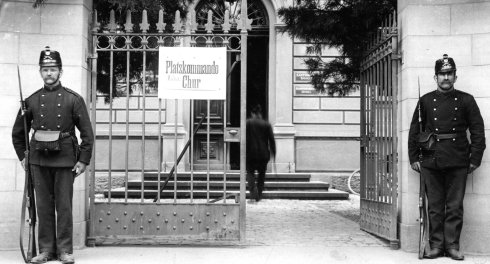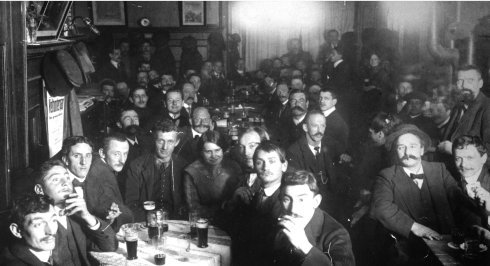1914–1918: Chur and the First World War
Shortly before the First World War, major projects were realized in the Graubünden capital: in 1913, the Graubünden Industry and Trade Exhibition took place, in 1914, the Quaderschulhaus was inaugurated and the Chur-Arosa Railway was opened. At the end of July 1914, the population of Graubünden reacted to the threat of war by buying hoarders. Repeatedly, the authorities assured the people that there was enough food and that there was no need to panic.
Sources:
Texts and images were taken from the brochure on the exhibition "Chur 1914-1918" of the Chur Municipal Archives from August 2014 to mid-January 2015.
The general mobilization
The boom phase ended with the First World War. General mobilization was ordered at the beginning of August 1914. The First World War had far-reaching effects on countries not directly involved in the war, such as neutral Switzerland. Chur suffered particularly from the consequences.
The social hardship during the First World War was felt especially by the working class. As a result of the general mobilization, men who had to serve had to leave their families and their jobs in order to do active service. This had drastic consequences: Many businesses reduced their offerings or remained closed because of the lack of workers. Above all, the loss of income was severe for those on active duty and their families, as there was no compensation. The nationwide food rationing, which had only been introduced in the spring of 1917, was tightened over time and in some cases lasted beyond the end of the war until 1920.
The Spanish flu
In the summer of 1918, the Spanish flu gripped Switzerland. In Graubünden, 753 civilians died, 76 of them in Chur. As a precautionary measure, events with large numbers of people were generally banned, including church services. Likewise, schools remained closed for some time. Nevertheless, many people fell ill with the aggressive flu virus. Hospitals were overcrowded, so emergency hospitals had to be set up.
At the end of October 1918, the Bündner Frauenschule on Loëstrasse was available to the civilian population as an influenza hospital, equipped with beds from restaurants for 100 patients. The emergency hospital was under the direction of Dr. Emil Köhl (1857-†1924, chief physician of Chur City Hospital) and his son, Dr. med. Hermann Köhl (1881-†1957, chief physician). The kindergarten on the Quai took in children of flu-stricken parents. From November, the Neubach embroidery factory on Gürtelstrasse served as an emergency hospital for the sick soldiers.
- 1900-1920: Ban on cars in Graubünden
- 1914–1918: Chur and the First World War
- The Daleu Cemetery and the Köhl Monuments
The general strike
From November 11 to 14, 1918, the general strike threw the entire country into turmoil. The city of Chur also felt the effects: the Chur-Arosa railroad, for example, only ran on a reduced schedule, and the "Freie Rätier" printed in Chur could not appear for two days. Municipal industrial enterprises such as the "Chokoladefabrik Grison" or the "Aktienbrauerei" went on strike. The climax of the movement was marked on November 14 by a protest meeting of about 600 people held in the Volkshaus (today: Hotel Chur). The Federal Council called in troops because of the threat to and disturbance of internal security. The military patrolled Chur, and guards guarded public buildings. Several people were arrested.
Impressum und rechtliche Hinweise

